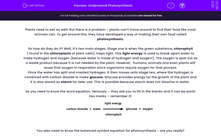Plants need to eat as well! But there is a problem - plants can’t move around to find their food like most animals can. To get around this, they have developed a way of making their own food called photosynthesis.
So how do they do it? Well, it’s two main stages. Stage one is when the green substance, chlorophyll ( found in the chloroplasts of plant cells), traps light. This light energy is used to break apart water to make hydrogen and oxygen (because water is made of hydrogen and oxygen!). The oxygen is spat out as a waste product because it is not needed by the plant. However, humans, animals and even plants will reuse that oxygen in respiration since organisms require oxygen for that process.
Once the water has split and created hydrogen, it then moves onto stage two, where the hydrogen is combined with carbon dioxide to make glucose. Glucose provides energy for the growth of the plant and it is also stored as starch for later use. This is possible because starch does not dissolve in water.
So you need to know the word equation. Seriously – they ask you to fill in the blanks and it can be worth two marks – remember it!

You also need to know the balanced symbol equation for photosynthesis - are you ready?
6CO2 + 6H2O -> C6H12O6 + 6O2
In order for plants to grow, glucose is turned into cellulose to make new cell walls. Vegetable fats and oils are also made of glucose and stored for future use. We extract them from plants and use them for cooking.
There's some complicated stuff to remember here but it is important to try to learn it. Now let's move on to some questions.








